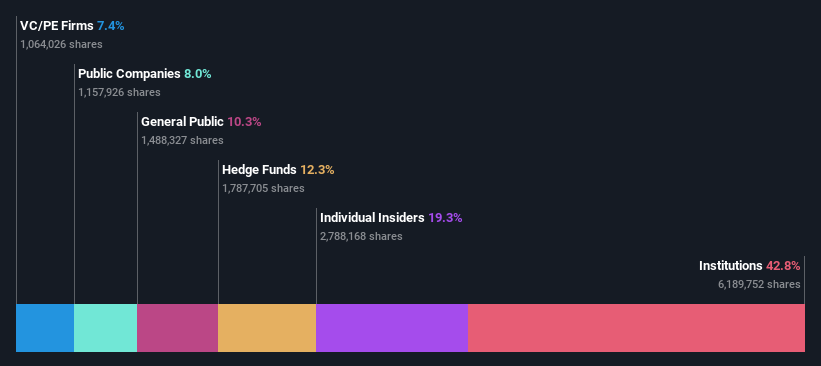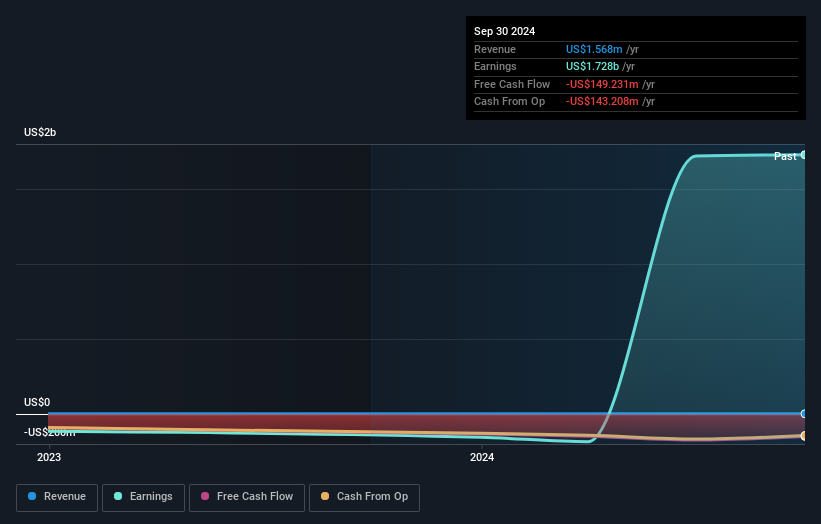- United States
- /
- Biotech
- /
- NasdaqGS:INBX
institutional investors of Inhibrx Biosciences, Inc. (NASDAQ:INBX) must be disappointed after last week's 15% drop

Key Insights
- Significantly high institutional ownership implies Inhibrx Biosciences' stock price is sensitive to their trading actions
- The top 7 shareholders own 50% of the company
- Insiders have been buying lately
To get a sense of who is truly in control of Inhibrx Biosciences, Inc. (NASDAQ:INBX), it is important to understand the ownership structure of the business. We can see that institutions own the lion's share in the company with 43% ownership. That is, the group stands to benefit the most if the stock rises (or lose the most if there is a downturn).
And last week, institutional endured the biggest losses as the stock fell by 15%.
In the chart below, we zoom in on the different ownership groups of Inhibrx Biosciences.
See our latest analysis for Inhibrx Biosciences

What Does The Institutional Ownership Tell Us About Inhibrx Biosciences?
Institutions typically measure themselves against a benchmark when reporting to their own investors, so they often become more enthusiastic about a stock once it's included in a major index. We would expect most companies to have some institutions on the register, especially if they are growing.
As you can see, institutional investors have a fair amount of stake in Inhibrx Biosciences. This implies the analysts working for those institutions have looked at the stock and they like it. But just like anyone else, they could be wrong. When multiple institutions own a stock, there's always a risk that they are in a 'crowded trade'. When such a trade goes wrong, multiple parties may compete to sell stock fast. This risk is higher in a company without a history of growth. You can see Inhibrx Biosciences' historic earnings and revenue below, but keep in mind there's always more to the story.

It would appear that 12% of Inhibrx Biosciences shares are controlled by hedge funds. That catches my attention because hedge funds sometimes try to influence management, or bring about changes that will create near term value for shareholders. Viking Global Investors LP is currently the company's largest shareholder with 12% of shares outstanding. Meanwhile, the second and third largest shareholders, hold 8.0% and 7.6%, of the shares outstanding, respectively. John Kayyem, who is the third-largest shareholder, also happens to hold the title of Member of the Board of Directors. Furthermore, CEO Mark Lappe is the owner of 6.4% of the company's shares.
On further inspection, we found that more than half the company's shares are owned by the top 7 shareholders, suggesting that the interests of the larger shareholders are balanced out to an extent by the smaller ones.
While it makes sense to study institutional ownership data for a company, it also makes sense to study analyst sentiments to know which way the wind is blowing. As far as we can tell there isn't analyst coverage of the company, so it is probably flying under the radar.
Insider Ownership Of Inhibrx Biosciences
The definition of company insiders can be subjective and does vary between jurisdictions. Our data reflects individual insiders, capturing board members at the very least. The company management answer to the board and the latter should represent the interests of shareholders. Notably, sometimes top-level managers are on the board themselves.
I generally consider insider ownership to be a good thing. However, on some occasions it makes it more difficult for other shareholders to hold the board accountable for decisions.
It seems insiders own a significant proportion of Inhibrx Biosciences, Inc.. Insiders have a US$39m stake in this US$200m business. This may suggest that the founders still own a lot of shares. You can click here to see if they have been buying or selling.
General Public Ownership
The general public-- including retail investors -- own 10% stake in the company, and hence can't easily be ignored. While this size of ownership may not be enough to sway a policy decision in their favour, they can still make a collective impact on company policies.
Private Equity Ownership
With a stake of 7.4%, private equity firms could influence the Inhibrx Biosciences board. Sometimes we see private equity stick around for the long term, but generally speaking they have a shorter investment horizon and -- as the name suggests -- don't invest in public companies much. After some time they may look to sell and redeploy capital elsewhere.
Public Company Ownership
It appears to us that public companies own 8.0% of Inhibrx Biosciences. This may be a strategic interest and the two companies may have related business interests. It could be that they have de-merged. This holding is probably worth investigating further.
Next Steps:
It's always worth thinking about the different groups who own shares in a company. But to understand Inhibrx Biosciences better, we need to consider many other factors. Case in point: We've spotted 3 warning signs for Inhibrx Biosciences you should be aware of.
Of course, you might find a fantastic investment by looking elsewhere. So take a peek at this free list of interesting companies.
NB: Figures in this article are calculated using data from the last twelve months, which refer to the 12-month period ending on the last date of the month the financial statement is dated. This may not be consistent with full year annual report figures.
New: AI Stock Screener & Alerts
Our new AI Stock Screener scans the market every day to uncover opportunities.
• Dividend Powerhouses (3%+ Yield)
• Undervalued Small Caps with Insider Buying
• High growth Tech and AI Companies
Or build your own from over 50 metrics.
Have feedback on this article? Concerned about the content? Get in touch with us directly. Alternatively, email editorial-team (at) simplywallst.com.
This article by Simply Wall St is general in nature. We provide commentary based on historical data and analyst forecasts only using an unbiased methodology and our articles are not intended to be financial advice. It does not constitute a recommendation to buy or sell any stock, and does not take account of your objectives, or your financial situation. We aim to bring you long-term focused analysis driven by fundamental data. Note that our analysis may not factor in the latest price-sensitive company announcements or qualitative material. Simply Wall St has no position in any stocks mentioned.
About NasdaqGS:INBX
Inhibrx Biosciences
A clinical-stage biopharmaceutical company, engages in the development of biologic therapeutics for people with life-threatening conditions.
Flawless balance sheet low.


